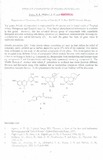| dc.description.abstract | The genus Psiadia (Compositae) is represented by 60 species and is found south of Tropical Africa, Madagascar and Tropical Asia (1). Very limited phytochemical information is available
in this genus. However, this has revealed diverse group of compounds with remarkable
biological activities including anti-tumor, cytotoxic (3), hemotoxic, neuromuscular blocking (4),
anti-helmintic and anti-inflammatory (2). As such the genus has been of great value in
traditional medicine.
Psiadia punctulata (DC) Vatke leaves whose decoctions are used in East Africa for relief of
abdominal pains, exhibits aerial surface deposition up to 25% w/w of dry material. Our current
work is focused on the study of the surface compounds of this plant. This investigation has so
far revealed three different kinds of compounds which include flavones with methoxylation on
. either A- or B-ring or both (e.g. Compound 1), diterpenoids (both trachyloban and kaurane types
e:g. compounds 2 and 3 respectively) and long chain cynnamoyl esters e.g. compound 4. The
Middle Eastern P arabica with which P punctulata is confused has about fourteen different
flavones and flavonols along with kaulane but no trachyloban diterpenes which confirms the
distinction between the two. In this presentation the results of our findings will be discussed. | en |

